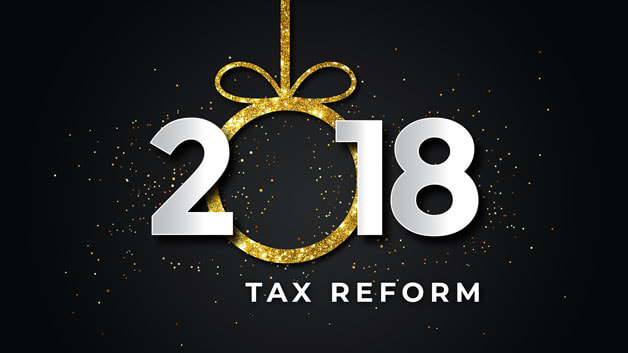|
In the federal budget bill passed February 9, Congress revived dozens of expired tax breaks retroactively for 2017. Here are the ones you may be able to use:
If you think you qualify for any of these, remember to bring all related documentation to your next tax filing appointment. The IRS is now scrambling to figure out how to apply these late changes to the already published 1040 tax form for 2017.
1 Comment
Congress has passed tax reform that will take effect in 2018, ushering in some of the most significant tax changes in three decades. Here are some of the most important items in the new bill that impact individual taxpayers. Individual Rule Changes
Because major tax reform like this is so rare, it's worth scheduling a tax planning consultation to ensure you get the most tax savings possible during 2018. Click here to contact Ellsworth & Associates and set up an appointment. The IRS recently announced mileage rates to be used for travel in 2018. The business mileage rate increases by one cent. The medical and moving mileage rates are also raised by one cent. Charitable mileage rates are unchanged. New Mileage Rates for 2018
Remember to properly document your mileage to receive full credit for your miles driven.
Both the House and Senate have passed versions of a tax reform bill. If a combined bill is passed and signed into law, it creates a unique window of possible tax savings during the last few weeks of 2017. But only if you prepare to act. Here are some tips. 4 Last-Minute Tax Moves to Make in 20171. Leverage less-valuable state and property deductions. The new bills reduce and potentially eliminate the ability to take state taxes and property taxes as an itemized deduction.
What to do now. Consider making next year’s initial estimated tax payment before the end of 2017. Do the same thing with property tax payments. As long as you are not subject to the alternative minimum tax (AMT), this is a one-time opportunity to get this tax benefit before it is reduced or eliminated. 2. Some itemized deductions are worth more this year. The tax law changes mean itemized deductions will be worth more to you this year than next. What to do now. Charitable contributions may be more valuable this year because they may offset income taxed at a much higher rate than it will be next year. The same may be true of mortgage interest and medical expense deductions that may be reduced or eliminated next year. 3. New tax rates and income brackets complicate matters. With different income tax rates and income brackets, it will be very difficult to get your withholdings estimated correctly. What to do now. Create a quick tax estimate based on your 2017 information before the end of the year. See if it makes sense to change your withholdings. 4. Lower small business taxes next year provide a unique opportunity. The tax rates on most businesses from C corporations to flow-through entities like S corporations and LLCs will be lower beginning next year with the passage of new legislation. What to do now. Deductions will be worth more to you in the 2017 tax year than next year, when income will be taxed at a lower rate.
If everything goes smoothly, new tax legislation will be signed into law in late December. This timing will give you very little time to act, so now is the time to prepare. The nimble taxpayer may have the opportunity make some tax-efficient moves in the waning days of 2017. There are a lot of new things to get used to when you change jobs, from new responsibilities to adjusting to a new company culture. One thing you may not have considered are the tax issues created when you change jobs. Here are tips to reduce any potential tax problems related to making a job change this coming year. 5 Tax Tips for Job Changers
Finding a new job can be an exciting experience, and one that can create tax consequences if not handled correctly. Feel free to call Ellsworth & Associates to discuss your individual situation. If you are eligible, now is the time to begin planning to take full advantage of your employer’s health flexible spending arrangement (FSA) during 2018.
FSAs provide employees a way to use tax-free dollars to pay medical expenses not covered by other health plans. Because eligible employees need to decide how much to contribute through payroll deductions before the plan year begins, many employers this fall are offering their employees the option to participate during the 2018 plan year. Interested employees wanting to contribute during the new year must make this choice again for 2018, even if they contributed in 2017. Self-employed individuals are not eligible. An employee who chooses to participate can contribute up to $2,650 during the 2018 plan year. That’s a $50 increase over 2017. Amounts contributed are not subject to federal income tax, Social Security tax or Medicare tax. If the plan allows, the employer may also contribute to an employee’s FSA. Throughout the year, employees can then use funds to pay qualified medical expenses not covered by their health plan, including co-pays, deductibles, and a variety of medical products and services ranging from dental and vision care to eyeglasses and hearing aids. Interested employees should check with their employer for details on eligible expenses and claim procedures. Under the use-or-lose provision, participating employees often must incur eligible expenses by the end of the plan year, or forfeit any unspent amounts. But under a special rule, employers may, if they choose, offer participating employees more time through either the carryover option or the grace period option. Under the carryover option, an employee can carry over up to $500 of unused funds to the following plan year—for example, an employee with $500 of unspent funds at the end of 2018 would still have those funds available to use in 2019. Under the grace period option, an employee has until two and a half months after the end of the plan year to incur eligible expenses — for example, March 15, 2019, for a plan year ending on Dec. 31, 2018. Employers can offer either option, but not both, or they can offer none at all. Employers are not required to offer FSAs. Accordingly, interested employees should check with their employer to see if they offer an FSA. Recording and reporting business expenses is a missed opportunity for many business owners and employees. Much of what you spend for business purposes is tax-deductible. Knowing whether you can or can't expense a purchase for business purposes can be difficult. Nevertheless, here are a few general guidelines to help. According to the IRS, business expenses must be ordinary and necessary to be deductible. That means they are normal and recognized in your business, as well as helpful and appropriate. You'll need to keep records (such as statements and ledgers) and supporting documents (receipts and invoices) to verify your deductions. Some expenses are subject to extra requirements, as described below. Travel ExpensesTravel expenses pertain to business trips and can include transportation to and from airports, your hotel and business meeting places. They also generally include lodging, meals, tips and other related incidentals.
Entertainment ExpensesEntertainment expenses need to be either directly connected to or related to the conduct of your business. That means that business is the foremost purpose of the activities and it's very probable you'll get income or future business benefits as a result. Expenses from entertainment that aren't considered directly related may still be deductible if they are associated with your business and occur just before or after a significant business conversation.
MileageBusiness use of your personal car is calculated according to your actual business-related expenses, or by multiplying your business mileage by the prescribed IRS rate (53.5 cents per mile in 2017).
The fall semester is in full swing. As teachers are getting to know a new group of students, they undoubtedly have a lot on their minds other than taxes. Still, remembering what to keep records of at this point can help lower their tax burden. There are three important work-related tax benefits that might help educators lessen their tax bill. There are tax deductions for teachers who have qualified expenses related to their profession. The cost of paying for things like classroom supplies, training, and travel might be deductible. The way to take advantage of these tax breaks depends on how you do your taxes: Claiming the Educator Expense Deduction (up to $250) or, for those who itemize their deductions, claiming eligible work-related expenses as a miscellaneous deduction on Schedule A. A third key benefit enables many teachers and other educators to take advantage of various education tax benefits for their continuing educational pursuits, especially the Lifetime Learning Credit or, in some cases depending on your circumstances, the American Opportunity Tax Credit. Educator Expense Deduction Educators can deduct up to $250 ($500 if married filing jointly and both spouses are eligible educators, but not more than $250 each) of unreimbursed business expenses. The educator expense deduction, claimed on either Form 1040 Line 23 or Form 1040A Line 16, is available even if an educator doesn’t itemize their deductions. To do so, the taxpayer must be a kindergarten through grade 12 teacher, instructor, counselor, principal, or aide for at least 900 hours a school year in a school that provides elementary or secondary education as determined under state law. Those who qualify can deduct costs like books, supplies, computer equipment and software, classroom equipment and supplementary materials used in the classroom. Expenses for participation in professional development courses are also deductible. Athletic supplies qualify if used for courses in health or physical education. Itemizing Deductions (Using Schedule A)Often educators have qualifying classroom and professional development expenses that exceed the $250 limit. In that case, they can claim these excess expenses as a miscellaneous deduction on Schedule A (Form 1040 or Form 1040NR). In addition, educators can claim other work-related expenses, such as the cost of subscriptions to professional journals, professional licenses, and union dues. Transportation expenses may also be deductible in situations such as, for example, where an educator assigned to teach at two different schools needs to drive from one school to the other on the same day. Miscellaneous deductions of this kind are subject to a two-percent limit. This means that a taxpayer must subtract two percent of their adjusted gross income from the total qualifying miscellaneous deduction amount. Keeping RecordsEducators should keep detailed records of qualifying expenses, noting the date, amount, and purpose of each purchase. This will help prevent a missed deduction at tax time.
Taxpayers should also keep a copy of their tax return for at least three years. Copies of tax returns may be needed for many reasons. If applying for college financial aid, a tax transcript may be all that is needed. A tax transcript summarizes return information and includes adjusted gross income. It seems like there’s a tax statute that touches on nearly every aspect of our lives. But that’s not all. Tax laws also include the lives of our furry friends. That’s right, even your pets can show up in your tax return in surprising ways. Your Pet Can Be... MedicineYou can actually deduct the cost of your pet as a medical expense in the tax code. Dogs in particular are frequently used to provide medical services as guides for the blind, hearing impaired or otherwise physically disabled. The cost of buying, training and maintaining a service animal is deductible. This includes the cost of food, grooming and visits to the vet. What’s not a deductible medical expense: therapy animals. Dogs and other furry creatures are commonly used in hospitals and other care facilities to lift the spirits of patients. But there’s no tax deduction yet for the service they provide. Your Pet Can Be... BusinessYou can also deduct the cost of a dog or other pet if you use it in your business. This could be a dog used to guard a location, or even a cat if it is used to control pests like mice and rats. Farmers who use herding dogs can also deduct their animals, and so can animal breeders. However, when you deduct animals as part of your business they are actually treated like capital equipment. That means you would depreciate the cost of the animal, generally over seven years, just as you would office furniture or other business equipment. Your Pet Can Be... A HobbyIf you make any money on your pet as part of a hobby, you may be able to deduct the cost of buying, training and maintaining your pet. This could be the case if, for example, you win prize money in a dog show. Your pet costs could be a miscellaneous itemized deduction as long as your total miscellaneous costs add up to at least 2 percent of your adjusted gross income. Unlike with a business, you can’t deduct losses from your hobby expenses. That means you can only deduct as much as you earn (from pet contests or other activities). Your Pet Can Be... A Sign of HomeIn a recent court ruling, the CEO of Match.com won his case against the New York tax agency in part because he proved his primary home was where he kept his dog. New York was trying to tax him as a resident because of his New York apartment. He was able to prove that he had moved to Texas because, among other reasons, that’s where his dog was. The move of items “near and dear tend to demonstrate a person’s intention,” the court ruled.
If you operate a business out of your home, you may be able to deduct a wide variety of expenses. These may include part of your rent or mortgage costs, insurance, utilities, repairs, maintenance, and cleaning costs related to the space you use. It is a tricky area of the tax code that's full of pitfalls for the unwary. Here are some of the top mistakes people make:
Simplified Home Office DeductionThere's a simple "safe harbor" home office deduction. You take the square footage of your office, up to 300 square feet, and multiply it by $5. This gives you a potential $1,500 deduction under the simplified option. However, your savings could be much greater than $1,500, so it's often worth getting help to calculate your full deduction using the standard rules.
|
Archives
February 2018
Categories
All
|
|
Ellsworth & Associates, Inc. CPAs
513.272.8400 Cincinnati: 9624 Cincinnati Columbus Road, Suite 209, Cincinnati, OH 45241
|
© 2017 Ellsworth & Associates, Inc.
|











 RSS Feed
RSS Feed